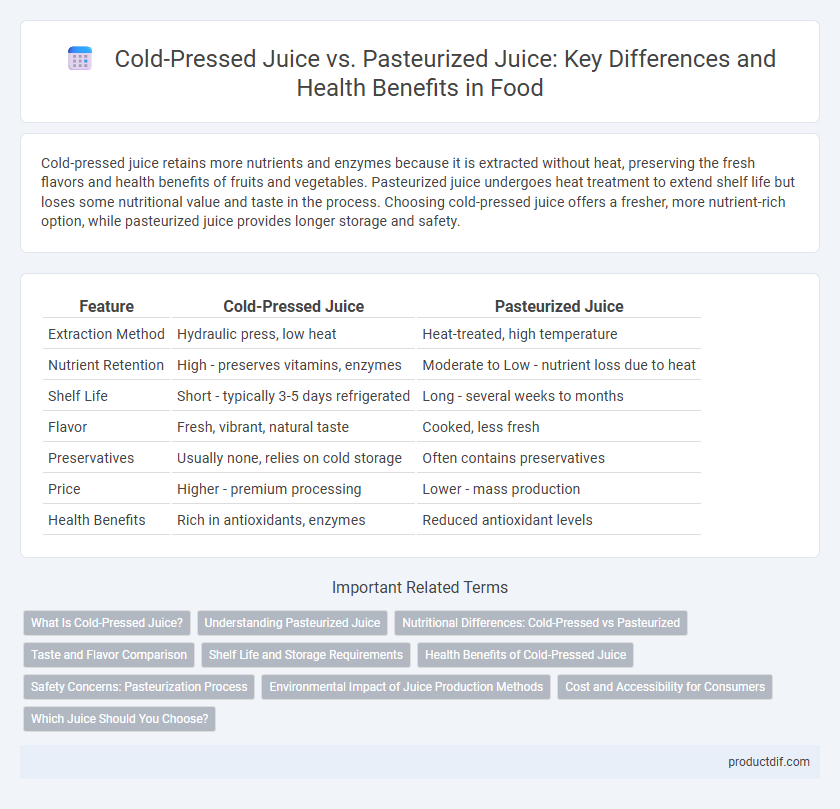Cold-pressed juice retains more nutrients and enzymes because it is extracted without heat, preserving the fresh flavors and health benefits of fruits and vegetables. Pasteurized juice undergoes heat treatment to extend shelf life but loses some nutritional value and taste in the process. Choosing cold-pressed juice offers a fresher, more nutrient-rich option, while pasteurized juice provides longer storage and safety.
Table of Comparison
| Feature | Cold-Pressed Juice | Pasteurized Juice |
|---|---|---|
| Extraction Method | Hydraulic press, low heat | Heat-treated, high temperature |
| Nutrient Retention | High - preserves vitamins, enzymes | Moderate to Low - nutrient loss due to heat |
| Shelf Life | Short - typically 3-5 days refrigerated | Long - several weeks to months |
| Flavor | Fresh, vibrant, natural taste | Cooked, less fresh |
| Preservatives | Usually none, relies on cold storage | Often contains preservatives |
| Price | Higher - premium processing | Lower - mass production |
| Health Benefits | Rich in antioxidants, enzymes | Reduced antioxidant levels |
What Is Cold-Pressed Juice?
Cold-pressed juice is extracted using a hydraulic press that crushes fruits and vegetables to preserve maximum nutrients and enzymes without heat exposure. This method prevents oxidation and retains the juice's natural flavors, vitamins, and antioxidants, making it a nutrient-dense option compared to traditional pasteurized juices. Cold-pressed juice typically has a shorter shelf life due to the absence of heat treatment, emphasizing freshness and raw ingredient quality.
Understanding Pasteurized Juice
Pasteurized juice undergoes heat treatment to eliminate harmful bacteria and extend shelf life, ensuring safety and durability during distribution. This process, which typically heats juice to 160degF for 15-30 seconds, may reduce some nutrient levels such as vitamin C and enzymes compared to cold-pressed alternatives. Despite nutrient loss, pasteurized juice remains a popular, convenient option with a longer shelf life and consistent flavor profile.
Nutritional Differences: Cold-Pressed vs Pasteurized
Cold-pressed juice retains higher levels of vitamins, enzymes, and antioxidants due to minimal heat exposure during extraction, preserving nutrients such as vitamin C and folate more effectively than pasteurized juice. Pasteurized juice undergoes heat treatment to eliminate pathogens, which can degrade heat-sensitive nutrients and reduce overall nutrient density. Consumers seeking maximum nutritional benefits and fresh flavor profiles often prefer cold-pressed juice for its superior retention of bioactive compounds compared to pasteurized alternatives.
Taste and Flavor Comparison
Cold-pressed juice retains more of the fruit's natural flavors and vibrant taste due to minimal heat exposure during extraction, preserving essential nutrients and enzymes. Pasteurized juice often has a smoother texture but may lose some flavor complexity and freshness because heat treatment can degrade delicate compounds. Consumers seeking a fresher, more intense fruit experience typically prefer cold-pressed juice over pasteurized options.
Shelf Life and Storage Requirements
Cold-pressed juice retains more nutrients but has a shorter shelf life, typically lasting 3 to 5 days when refrigerated at 32degF to 39degF. Pasteurized juice undergoes heat treatment, extending its shelf life to several weeks or months and allowing storage at room temperature until opened. Proper refrigeration of cold-pressed juice is essential to prevent spoilage, while pasteurized juice requires no refrigeration prior to opening but should be refrigerated after.
Health Benefits of Cold-Pressed Juice
Cold-pressed juice retains more vitamins, enzymes, and antioxidants due to minimal heat exposure during extraction, preserving essential nutrients better than pasteurized juice. This method enhances nutrient absorption, supporting improved digestion, immune function, and increased energy levels. Consuming cold-pressed juice may reduce inflammation and promote overall well-being through higher concentrations of bioactive compounds.
Safety Concerns: Pasteurization Process
Pasteurization eliminates harmful bacteria and pathogens in juice by heating it to specific temperatures, significantly reducing the risk of foodborne illnesses. Cold-pressed juice, while retaining more nutrients due to minimal heat exposure, lacks this safety step and may harbor microbes if not handled properly. Understanding the trade-off between nutrient retention and pathogen elimination is crucial for making informed choices about juice consumption.
Environmental Impact of Juice Production Methods
Cold-pressed juice production uses hydraulic pressing, which consumes less energy and preserves more nutrients compared to the high-heat treatment in pasteurization that requires significant electricity and water resources. Pasteurized juice production generates higher carbon emissions due to prolonged heating and cooling cycles, whereas cold-pressed juice typically involves shorter processing times and lower waste output. Sustainable sourcing and packaging choices further influence the overall environmental footprint of both cold-pressed and pasteurized juice production methods.
Cost and Accessibility for Consumers
Cold-pressed juice typically costs 2 to 3 times more than pasteurized juice due to expensive extraction methods and shorter shelf life. Pasteurized juice enjoys wider accessibility in supermarkets and convenience stores, benefiting from mass production and longer shelf stability. Consumers seeking premium nutrition face higher prices and limited availability with cold-pressed options, while pasteurized juice offers affordable and readily available choices.
Which Juice Should You Choose?
Cold-pressed juice retains more nutrients and enzymes due to minimal heat exposure, making it a healthier option rich in vitamins and antioxidants. Pasteurized juice offers a longer shelf life and enhanced safety by eliminating harmful bacteria through heat treatment. Choose cold-pressed juice for maximum nutrient content and fresh flavor, or pasteurized juice for convenience and extended storage.
Cold-Pressed Juice vs Pasteurized Juice Infographic

 productdif.com
productdif.com